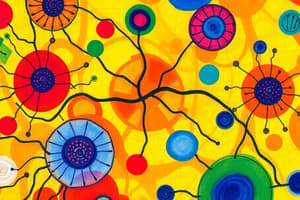Podcast
Questions and Answers
What role do stomata play in photosynthesis?
What role do stomata play in photosynthesis?
- They facilitate the uptake of nutrients from the soil.
- They absorb carbon dioxide from the atmosphere. (correct)
- They store excess water for plant use.
- They release oxygen during cellular respiration.
How do stomata influence transpiration in plants?
How do stomata influence transpiration in plants?
- They enhance nutrient absorption from the soil.
- They absorb water through the leaf surface.
- They regulate water loss by opening and closing. (correct)
- They prevent water from escaping during dry conditions.
Which process is primarily affected by stomata?
Which process is primarily affected by stomata?
- Nutrient uptake
- Photosynthesis (correct)
- Translocation
- Cellular respiration
What would happen to a plant if its stomata were completely closed?
What would happen to a plant if its stomata were completely closed?
In what condition would stomata typically close to conserve water?
In what condition would stomata typically close to conserve water?
Which factor does NOT influence the opening and closing of stomata?
Which factor does NOT influence the opening and closing of stomata?
How does the opening of stomata relate to plant respiration?
How does the opening of stomata relate to plant respiration?
What effect does high transpiration rate have on a plant?
What effect does high transpiration rate have on a plant?
What does the cell theory state about all living things?
What does the cell theory state about all living things?
Which of the following correctly identifies a characteristic of prokaryotic cells?
Which of the following correctly identifies a characteristic of prokaryotic cells?
Which organelle is responsible for energy production in eukaryotic cells?
Which organelle is responsible for energy production in eukaryotic cells?
What function does the cell membrane serve?
What function does the cell membrane serve?
Which statement best describes the difference between light microscopes and electron microscopes?
Which statement best describes the difference between light microscopes and electron microscopes?
What is the primary function of chloroplasts in plant cells?
What is the primary function of chloroplasts in plant cells?
Which of the following best describes the role of natural flora in human health?
Which of the following best describes the role of natural flora in human health?
What is the significance of the surface area to volume ratio in cells?
What is the significance of the surface area to volume ratio in cells?
Which of the following is NOT a component of cell theory?
Which of the following is NOT a component of cell theory?
What are the main components of blood and their primary functions?
What are the main components of blood and their primary functions?
Which organ is not part of the human respiratory system?
Which organ is not part of the human respiratory system?
What condition is characterized by inflammation and narrowing of the airways?
What condition is characterized by inflammation and narrowing of the airways?
How does penicillin primarily work to combat pathogens?
How does penicillin primarily work to combat pathogens?
Which of the following describes a potential problem associated with antibiotic overuse?
Which of the following describes a potential problem associated with antibiotic overuse?
Which term refers to the functional unit of the kidney involved in filtering blood?
Which term refers to the functional unit of the kidney involved in filtering blood?
Which characteristic is not typical of the human circulatory system?
Which characteristic is not typical of the human circulatory system?
Flashcards
Cell Theory
Cell Theory
All living things are made of cells, cells are the basic unit of life, and new cells come from existing cells.
Electron Microscope
Electron Microscope
A microscope that uses beams of electrons to magnify objects; allows for much greater magnification than light microscopes.
Compound Light Microscope
Compound Light Microscope
A microscope that uses visible light and multiple lenses to magnify objects.
Cell Membrane
Cell Membrane
Signup and view all the flashcards
Surface Area to Volume Ratio
Surface Area to Volume Ratio
Signup and view all the flashcards
Chloroplast
Chloroplast
Signup and view all the flashcards
Mitochondria
Mitochondria
Signup and view all the flashcards
Ribosomes
Ribosomes
Signup and view all the flashcards
Natural Flora
Natural Flora
Signup and view all the flashcards
Pathogens
Pathogens
Signup and view all the flashcards
Penicillin
Penicillin
Signup and view all the flashcards
Antibiotic Overuse
Antibiotic Overuse
Signup and view all the flashcards
Digestion
Digestion
Signup and view all the flashcards
Peristalsis
Peristalsis
Signup and view all the flashcards
Chyme
Chyme
Signup and view all the flashcards
Villi
Villi
Signup and view all the flashcards
Atoms and Elements
Atoms and Elements
Signup and view all the flashcards
Bonding
Bonding
Signup and view all the flashcards
Physical Change
Physical Change
Signup and view all the flashcards
Chemical Change
Chemical Change
Signup and view all the flashcards
Reactants and Products
Reactants and Products
Signup and view all the flashcards
Collision Theory
Collision Theory
Signup and view all the flashcards
Catalyst
Catalyst
Signup and view all the flashcards
Study Notes
Year 8 Science Exam Revision 2024
- Exam date: See exam timetable
- Topics covered: Term 3 (Cells, Body Systems), Term 4 (Physical and Chemical Changes)
- Exam duration: 60 minutes (with 5 minutes reading time)
- Equipment needed: Black/blue pen, pencil, eraser, ruler
Revision Guidelines
- Print and complete a study timetable to designate days/nights for preparation
- Use "Key areas" and "You should be able to" sections for topic summaries
- Include key definitions/glossary words
- Include useful diagrams with labels
- Include helpful hints for remembering things
- Include simple explanations of important concepts using glossary words
- Complete review questions to test understanding
- Use past topic tests/revision sheets for further review
- Use online program Quizlet for online review and sharing with peers
Term 3: Cells
- Key Areas Covered: Cell Theory, Plant and Animal Cells, Microscopes, Organelles, Bacteria and Fungal Cells
- Glossary Terms: Binary fission, Binocular, Cell, Cell membrane, Cell theory, Chlorophyll, Chloroplast, Compound light microscope, Cytoplasm, DNA, Electron microscope, Eukaryotic cell, etc.
- Learning Intentions: Explain cell theory, compare and contrast light and electron microscopes, calculate magnification, describe cell functions (membrane, cytoplasm, DNA, mitochondria, ribosomes, chloroplasts, vesicles), compare natural flora and pathogens, explain the benefits of natural flora to human health, describe the development of penicillin and problems associated with antibiotic overuse.
Term 3: Body Systems
- Key Areas Covered: Cells, organs, tissues, Digestive System, Respiratory System, Circulatory System, Excretory System, Plant Systems
- Glossary Terms: Abomasum, Alveoli, Amino acids, Ammonia, Aorta, Arterioles, etc.
- Learning Intentions: Define digestion, peristalsis, chyme, villi, list main digestive organs, describe differences in digestive systems, describe digestive malfunctions, identify key respiratoy organs (trachea, bronchi, lungs, pharynx, epiglottis, alveoli, diaphragm), describe symptoms of asthma, emphysema and pneumonia, list key circulatory organs (capillaries and veins), describe blood components, describe main circulatory diseases (e.g., coronary heart disease), describe key excretory organs (kidneys, skin, bladder, liver), explain the structure and function of a nephron, list and describe plant tissues (stems, leaves, roots, xylem, phloem), describe stomata's function in transpiration and photosynthesis.
Term 4: Physical and Chemical Change
- Key Areas Covered: Atoms and elements, bonding, physical change, chemical change, reaction rates
- Glossary Terms: Atom, boiling point, catalyst, chemical reaction, collision theory, combustion, compound, etc. (see further details from the document)
- Learning Intentions: Define and describe features of the periodic table, relate atomic number/mass number to subatomic particles, define/explain molecules, compounds, elements, and mixtures, define vaporisation/condensation/melting/etc., explain physical vs chemical changes, define chemical reactions, describe collision theory, concentration, catalysts, enzymes, explain factors that increase reaction rates, classify recycling of plastic as physical or chemical changes, describe the benefits of recycling.
Studying That Suits You
Use AI to generate personalized quizzes and flashcards to suit your learning preferences.




